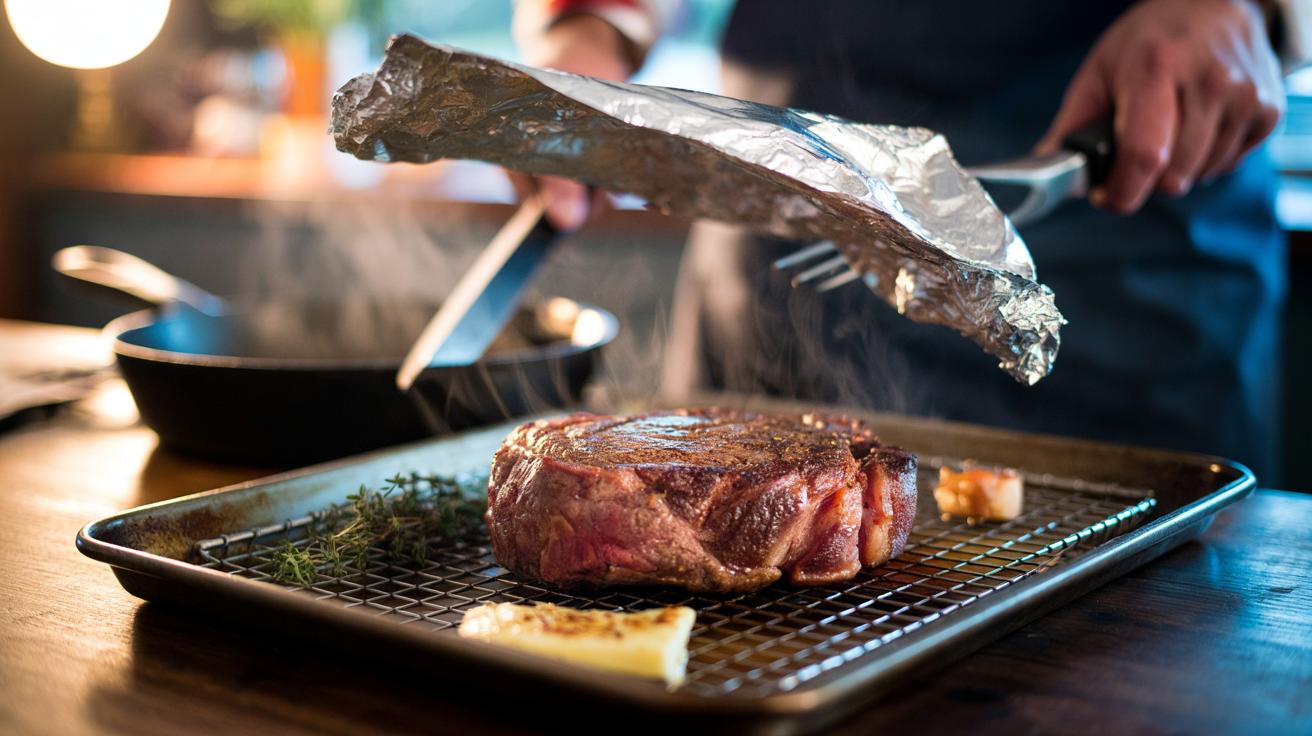In a nutshell
- 🔬 Resting lets juices redistribute as muscle fibres relax, pressure equalises, and carryover heat gently completes the cook for better tenderness.
- ⏱️ Follow practical timings: about 1 minute per centimetre for steaks and 10–15 minutes per kilogram for roasts, accounting for a 2–6°C carryover rise.
- 🧰 Use smart techniques: pull meat slightly early, rest on a wire rack over a tray, and apply a loose foil tent to retain warmth without steaming.
- 🧂 Boost juiciness and flavour with a dry brine, end-of-cook butter basting, and careful handling—avoid piercing, flip once, and hold at 50–60°C if timing slips.
- 🥩 Expect superior results: tender texture, vibrant flavour, cleaner slices with less purge, and better leftovers thanks to moisture retained during the pause.
Ask a seasoned chef how to get a steak that eats like velvet and they’ll point you to a deceptively simple step: the resting-time method. After heat has done its work, a short, deliberate pause lets juices redistribute and pressure inside the meat subside, delivering a bite that’s both tender and vividly flavourful. Cut too soon and you’ll watch precious moisture spill onto the board. This is not culinary superstition; it’s applied kitchen physics. By managing carryover heat, latent steam, and muscle-fibre relaxation, resting creates the conditions for consistent texture from edge to centre. Whether you’re pan-searing a sirloin or roasting a leg of lamb, those quiet minutes off the heat are the difference between good and exceptional.
What Happens Inside Meat While It Rests
Cooking drives water toward the centre as muscle fibres contract, particularly as myosin and, at higher temperatures, actin coagulate. That contraction raises internal pressure, so when a knife breaches the surface immediately, fluid escapes. Resting allows that pressure gradient to ease and moisture to move back into spaces between fibres. Think of it as a gentle reset: proteins firm enough to hold structure, yet relaxed enough to reabsorb liquid. Meanwhile, carryover heat nudges the internal temperature up a few degrees, finishing the cook without direct flame or pan contact.
Two more changes help tenderness. First, dissolved gelatine from melted collagen lubricates fibres, giving a succulent mouthfeel. Second, as surfaces cool slightly, viscosity increases and juices thicken, so they cling rather than run. The effect is especially pronounced in thicker cuts where heat penetration is uneven. Resting also reduces “purge” on slicing, preserving both myoglobin-rich colour and savour. In short, pause periods don’t create extra juice— they keep more of it in your bite.
How Long to Rest: A Practical Guide for Home Cooks
Time depends on thickness, mass, and target doneness. Thin chops and 2 cm steaks settle quickly; large roasts need longer for heat equalisation. A useful rule: rest roughly one minute per centimetre of thickness for steaks, and 10–15 minutes per kilogram for roasts, adjusting if you aim for medium or if your kitchen is cool. Always factor in a 2–6°C carryover rise that can push medium-rare into medium if you don’t plan for it. Tent with foil loosely to avoid trapping steam, which softens crusts; a warm plate or low oven (about 60°C) maintains temperature without overcooking.
Rest on a wire rack to prevent soggy bottoms and rotate once for even heat distribution. Keep food safety in mind: long holds below 60°C are unwise, so plan carving and sides to sync with the pause. Let the final temperature be your guide—pull a touch early, then allow the rest to finish the job.
| Cut/Thickness | Typical Rest Time | Carryover Rise | Tips |
|---|---|---|---|
| 2 cm steak (sirloin/ribeye) | 5–7 minutes | 1–2°C | Loose foil tent; warm plate |
| 4 cm steak (rump/porterhouse) | 8–10 minutes | 2–3°C | Wire rack; baste before rest |
| Small roast (1–1.5 kg) | 15–20 minutes | 3–5°C | Collect pan juices while resting |
| Large roast (2–3 kg) | 30–45 minutes | 4–6°C | Hold in low oven; don’t smother |
| Slow-cooked brisket/pork shoulder | 45–90 minutes | 1–3°C | Wrap and hold insulated; vent briefly |
Techniques That Maximise Juiciness During the Pause
Start by pulling meat just shy of target temperature, anticipating carryover heat. Park it on a rack set over a tray, which preserves your crust and catches drips for gravy. A light foil tent prevents excessive heat loss without steaming; leave a gap for airflow. Season early with a dry brine (salt 1–24 hours ahead) to help proteins retain water and deepen flavour. For pan-cooked steaks, baste with butter and aromatics in the final minute, then rest—those flavour compounds stabilise and bloom during the pause.
Manage the carve. Always slice across the grain to shorten fibres and increase perceived tenderness, and for roasts, separate major muscles along natural seams before slicing. Flip once midway through the rest for even warmth. If timing slides, hold at 50–60°C in the oven door-ajar to protect the crust. Avoid stabbing with forks; use tongs. Most of all, resist the urge to rush—those quiet minutes pay back in every bite.
The science is straightforward: heat tightens fibres, resting relaxes them, and rebalanced pressure keeps flavour where it belongs. Respect that rhythm and the results follow—brightly juicy steaks, roasts that carve cleanly, and leftovers that reheat better because they didn’t lose moisture at the board. Build the pause into your plan, align sides to finish on time, and let carryover heat do the last bit of work while you make the sauce. Once you taste the difference, there’s no going back. Which cut will you test next with a deliberate pause, and how will you tweak the timing to suit your kitchen and taste?
Did you like it?4.5/5 (24)
